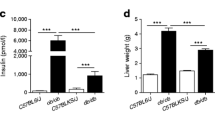Abstract
This study was achieved with the aim to find metabolic changes between Fischer rats with different dipeptidyl peptidase-type 4 (DPPIV) expression. The DPPIV is an enzyme expressed in several tissues and is critically involved in the regulation of meal-related insulin secretion in healthy individuals. The metabolic consequences of chronic DPPIV inhibition were analyzed in a surrogate animal model of genetic enzyme deficiency. Hyphenated gas chromatography–mass spectrometry (GC–MS) and multivariate data analysis techniques were used to study the metabolic aqueous fraction profile of 18 plasma and liver samples in two syngeneic rat strains differing in DPPIV activity (DPPIV+ vs. DPPIV−). The hyperglycemic response following oral glucose administration was attenuated in DPPIV− rats, as expected. Statistical significant differences between the two strains were observed among the low molecular weight polar metabolites analyzed from plasma and liver.
These included a decrease in malic acid and glutamine and an increase in pyroglutamic acid, serine, and alanine in plasma of DPPIV− rats. In addition, palmitic acid, l-proline, and ribitol were decreased in the liver of DPPIV− strain. Such alterations were compatible with a normal phenotype. These results suggest that long-term exposure to DPPIV inhibitors looks compatible with an overall balanced metabolism.




Similar content being viewed by others
References
Caboni P, Murgia A, Porcu A, Demuru M, Pulina G, Nudda A (2016) Gas chromatography-mass spectrometry metabolomics of goat milk with different polymorphism at the α S1-casein genotype locus. J Dairy Sci 99(8):6046–6051
De Fronzo RA, Hissa MN, Garber AJ, Gross JL, Duan RY, Ravichandran S et al (2009) The efficacy and safety of saxagliptin when added to metformin therapy in patients with inadequately controlled type 2 diabetes with metformin alone. Diabetes Care 32(9):1649–1655
Drucker DJ, Nauck MA (2006) The incretin system: glucagon-like peptide-1 receptor agonists and dipeptidyl peptidase-4 inhibitors in type 2 diabetes. Lancet 368(9548):1696–1705
Emmett M (2014) Acetaminophen toxicity and 5-oxoproline (pyroglutamic acid): a tale of two cycles, one an ATP-depleting futile cycle and the other a useful cycle. Clin J Am Soc Nephrol 9(1):191–200
Erickson RH, Suzuki Y, Sedlmayer A, Kim YS (1992) Biosynthesis and degradation of altered immature forms of intestinal dipeptidyl peptidase IV in a rat strain lacking the enzyme. J Biol Chem 267(30):21623–21629
Eriksson L, Byrne T, Johansson E, Trygg J, Vikström C (2013) Multi-and megavariate data analysis basic principles and applications. Umetrics Academy
Gallagher EJ, LeRoith D, Stasinopoulos M, Zelenko Z, Shiloach J (2016) Polyol accumulation in muscle and liver in a mouse model of type 2 diabetes. J Diabetes Complicat 30(6):999–1007
Matsui T, Nakashima S, Nishino Y, Ojima A, Nakamura N, Arima K, Yamagishi SI (2015) Dipeptidyl peptidase-4 deficiency protects against experimental diabetic nephropathy partly by blocking the advanced glycation end products-receptor axis. Lab Investig 95(5):525–533
Mitani H, Takimoto M, Hughes TE, Kimura M (2002) Dipeptidyl peptidase IV inhibition improves impaired glucose tolerance in high-fat diet-fed rats: study using a Fischer 344 rat substrain deficient in its enzyme activity. Jpn J Pharmacol 88(4):442–450
Murgia A, Mancuso L, Manis C, Caboni P, Cao G (2016) GC-MS metabolomics analysis of mesenchymal stem cells treated with copper oxide nanoparticles. Toxicol Mech Methods 26(8):611–619
Nagakura T, Yasuda N, Yamazaki K, Ikuta H, Yoshikawa S, Asano O et al (2001) Improved glucose tolerance via enhanced glucose-dependent insulin secretion in dipeptidyl peptidase IV-deficient Fischer rats. Biochem Biophys Res Communic 284(2):501–506
Nauck MA, Vardarli I, Deacon CF, Holst JJ, Meier JJ (2011) Secretion of glucagon-like peptide-1 (GLP-1) in type 2 diabetes: what is up, what is down? Diabetologia 54(1):10–18
O'Harte F, Gault V, Parker J, Harriott P, Mooney M, Bailey C, Flatt P (2002) Improved stability, insulin-releasing activity and antidiabetic potential of two novel N-terminal analogues of gastric inhibitory polypeptide: N-acetyl-GIP and pGlu-GIP. Diabetologia 45(9):1281–1291
Scano P, Murgia A, Pirisi FM, Caboni P (2014) A gas chromatography-mass spectrometry-based metabolomic approach for the characterization of goat milk compared with cow milk. J Dairy Sci 97(10):6057–6066
Serra MP, Marongiu F, Marongiu M, Contini A, Laconi E (2015) Cell-autonomous decrease in proliferative competitiveness of the aged hepatocyte. J Hepatol 62(6):1341–1348
Tahrani AA, Bailey CJ, Del Prato S, Barnett AH (2011) Management of type 2 diabetes: new and future developments in treatment. Lancet 378(9786):182–197
Thompson NL, Hixson DC, Callanan H, Panzica M, Flanagan D, Faris RA et al (1991) A Fischer rat substrain deficient in dipeptidyl peptidase IV activity makes normal steady-state RNA levels and an altered protein. Use as a liver-cell transplantation model. Biochem J 273(3):497–502
Acknowledgements
We thank Mrs. Anna Saba and Mr. Roberto Marras for their technical contribution.
Author information
Authors and Affiliations
Corresponding author
Ethics declarations
Animal studies were reviewed and approved by the Institutional Animal Care and Use Committee of the University of Cagliari (Aut. No. 840/2014-PR).
Conflict of interest
The authors declare that there are no conflicts of interest.
Rights and permissions
About this article
Cite this article
Murgia, A., Caboni, P., Cadoni, E. et al. A GC–MS untargeted metabolomics analysis in the plasma and liver of rats lacking dipeptidyl-peptidase type IV enzyme activity. J Physiol Biochem 73, 575–582 (2017). https://doi.org/10.1007/s13105-017-0588-7
Received:
Accepted:
Published:
Issue Date:
DOI: https://doi.org/10.1007/s13105-017-0588-7




